The wonderful seaside town of Antibes in the south of France is nestled along the shores of Provence. A comprehensive stroll through the village of Antibes only takes a couple of hours, wandering through the quiet lanes of the pedestrian zone of the Old Town of Antibes. It is perfect for a stroll about for an hour or two, maybe sit at a café, grab some lunch. It's such a small town, you're probably not spending the night in Antibes – you certainly could, there are some small hotels here but more likely you're using a bigger city as a home base such as Nice, which is what we prefer, ideally staying overnight in the city of Nice for at least four nights.
Nice is just 20 km away from Antibes, with very frequent train service. You have easy access from the Nice train station to many points along the coastline and to get from Nice to Antibes by train only takes about 20 minutes, so that's very convenient. The trains run two or three times every hour, so it's never a long wait. The seats are comfortable and as long as you're avoiding rush hour, they are generally not crowded, and there's beautiful scenery out the window as well.
See two videos in dedicated pages:
.jpg)
Antibes is a significant town, so many trains do stop here. Upon arriving you'll see the Antibes train station is adjacent to the center, leaving just a short 10-minute walk to get into the village proper. The Old Town of Antibes is a small area, just several hundred meters long and wide, but wonderful to explore and riddled with dozens of tiny lanes.
Three hours is a reasonable time for a good look, including a snack or two along the way. On the other hand if you are in a rush, with only one hour, you could head directly from station to marina, then to the food market and main square, Place Nationale, then out – but do allow more time because this special village deserves a close look. It's a fascinating place with a great history that goes back two and a half thousand years at least (summarized below). Your time here is primarily spent walking through the little lanes, into the markets, along the shoreline, appreciating the old buildings and the people, mostly local residents.
Walk straight out of the train station two blocks along Avenue de la Libération to the marina. Typical of most wealthy Riviera coastal towns, the marina is filled with beautiful yachts – sailboats and motorboats, some moored here permanently, others just passing through. In the distance you see a fortress, Fort Carré, a 16th-century star-shaped fort built on the site of earlier fortifications. It was designed by Vauban, Louis XIV’s celebrated engineer, who built or restructured 130 strongholds throughout France during his 53-year career. Napoleon was briefly imprisoned here during the French Revolution. The fort looks like an island from here, but it's on a peninsula.

Continue on Avenue de Verdun along the length of the medieval Curtain Wall past the marina where you see an arched gate in the city wall with cars driving through. At this point you have 3 alternate routes depending on your energy, time and interests: short route directly into the Old Town; or slightly longer, continuing to seashore; or with added detour along the seawall, as shown on map and explained here.
The shortest route is through the gate on Rue Aubernon and directly into the Old Town. In this case when you get inside the walls of the Old Town you'll find some automobile traffic on a few streets with cars going slowly by, so keep walking and within a couple more blocks you will reach the pedestrian-only zone.
.jpg)
For a slightly longer and more scenic route, don’t go through that big gate but instead keep walking another block past it along the shoreline to gain lovely waterfront views, and then enter through a quieter side path into the Old Town. Perhaps while at the shore take a left for a short round-trip detour out along the seawall towards Bastion St-Jaume for a close-up look at the modern sculpture and excellent views back across the marina.
-04.jpg)
Continuing around the bend on the right side to the ramparts, Rampe des Saleurs (named for fishermen who used to salt their catch here), which leads to an observation sidewalk for a nice view looking out on the sea. Antibes was once a fortified village like most of the other towns in the south of France, with the original wall running along the shore, and with these ramparts, it still seems like a medieval fortified town. Just beyond the bend in the road, now called Promenade de l’Amiral de Grasse, walk through any of several paths between the buildings leading into the pedestrian zone.
You are now in the oldest part of Antibes, a charming residential neighborhood around Place du Révély with two main pedestrian lanes, Rue de l’Horloge and Rue du Saint-Esprit, either of which will bring you to the former Cathedral and the old Grimaldi Palace that is now the Picasso Museum, with more peaceful residential pedestrian lanes beyond. Notice the arches in several side alleys linking the buildings together to help support each other as if holding hands.
.jpg)
The Church of the Immaculate Conception is of the oldest buildings in town, a medieval church first built from the 12th century. It's believed to be on the site of a much earlier Greek temple and perhaps some stones from the ancient Romans were used in its construction. The two adjacent medieval towers are believed to stand on Roman foundation stones.
Until the 1200s when the bishop moved for safety to Grasse, the church had been the regional Cathedral, and therefore is highly decorated inside with artworks from the Renaissance and Baroque periods, with Romanesque style architecture in the interior reflecting medieval heritage. It's a beautiful place to stop in, sit down, have a rest, cool off a bit and enjoy the scenic surroundings. There is no admission charge to the church and it’s open throughout the day plus there are comfortable benches. With the beautiful paintings and sculpture it's like an art museum and for the religious visitor a great place to say a prayer.
.jpg)
The large Picasso Museum is next door in the Grimaldi Palace, where the artist lived in 1946 and had a studio that's now incorporated into the museum. Antibes was famous as a home for artists in the 20th century, Picasso in particular, who spent most of his later life in various homes in Provence. Picasso donated 22 of his paintings to the museum, which also has works by other important artists of the modern movement. There are a handful of other museums and many art galleries in Antibes as well.

This Grimaldi Castle was first inhabited in 1385 by that noble family from Monaco, the Grimaldi's, who actually ruled over a very large area here along the shores of Provence and inland. It's believed that earlier, this locale was the Greek center of an ancient city about 2 1/2 thousand years ago. Antibes was first founded by the Greeks and then later built up by the Romans, and this little neighborhood was their center.

You will reach the busy part of the Old Town with its shops and beautiful squares in just a little while, but first it’s nice to start out in these quiet little residential alleys – old bricks covered with colorful ivy with a domestic feeling to this initial neighborhood. You'll walk by some open shop doors and you're welcome to have a peek inside – notice a carpenter workshop, fascinating with all his tools. This is a charming neighborhood, very quiet and it's a pedestrian zone even for the houses, so these people walk to get to their house. It's rewarding to get off the beaten track now and then to see how people live in the non-touristic residential areas.
.jpg)
There are several nice, but less important, residential blocks straight beyond the Picasso Museum you could venture into now, for example have a peek down Rue du Bateau just beyond the museum. Save the lanes beyond for later if you have time while you are walking along Rue James Close, which also connects with them, as described below.
From the church it is one block to the famous food market, Cours Massena, one of the highlights of town, especially if you are here before noon when the veggie market is in full swing. No matter which direction you come from, the Cours Massena food market is very easy to find in this small Old Town, just a few blocks from the main square, Place Nationale. It's a fantastic covered produce market where you'll find piles and piles of local fruits and vegetables –the greens, tomatoes, lots of potatoes, and plenty of locals hanging out.
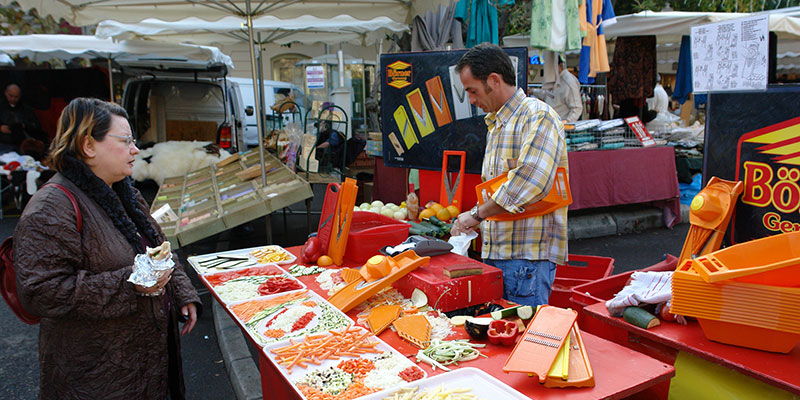
Of course the south of France is famous for its food markets and this is one of the best and especially convenient because, good news, it's open every day from June 1 to September 1 – from about 6 AM and goes strong until about 1 PM. In the off-season it closes on Mondays. So this is a very regular market that you're sure to catch, in such a beautiful outdoor setting; semi-covered, you've got a roof overhead with the open air and lots of locals streaming around, there's flowers for sale, colors everywhere. It's just a great spot to visit and to take a lot of pictures. And then in the afternoon the same covered market hall becomes a craft market with the same kind of hours. So whether here in the morning or later in the afternoon there's always something to see.
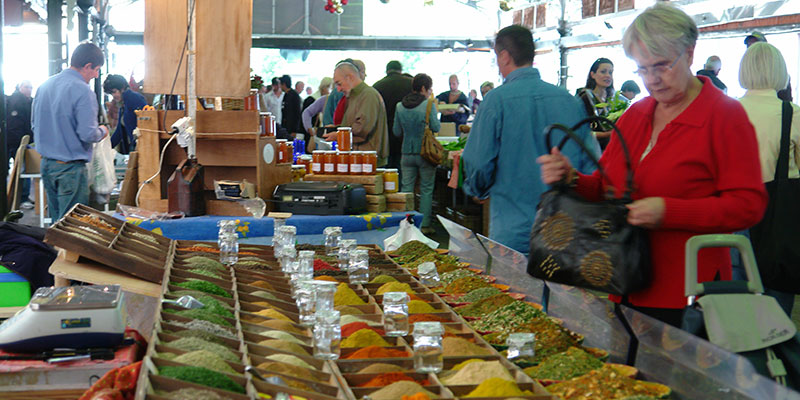
Several booths offers dozens of colorful aromatic spices that add zest to the local cuisine, and make a good purchase to bring home. Olives are the heart of the Mediterranean diet and come in a wide variety of sizes, shapes, colors and textures, and many different kinds of olive oils and tapenades to go with it, and a favorite is tapenade made from crushed olives. Tapenade, try some of this. You’ve had tapenade before of course, you know it’s good but you didn’t find out how good until you get it fresh at a French market like this. Those jars of tapenade are easy to pack and you can bring them home, no problem.
The merchants are there to sell you things but they also give away free samples, black, green and yellow, three different olives – just ask, they all speak some English so you can very easily communicate have a great time with them. The olive tree was first planted in the area by the Greeks 2500 years ago and it's been thriving ever since, as has the other produce, with the sunny climate, mild temperatures and the stony soil, a perfect combination for agriculture.
It's very satisfying to deal directly with the farmers and the friendly people who are making these food products. It's good business for them and you're getting fresh goods at the best price while supporting the local economy.

You probably are not cooking food on your vacation and you just wandered into the market to have a look and take a few pictures, but you will be tempted to purchase some of the fresh fruits, nuts, other snack foods like cranberries. There are cafés around the market stalls as well, so it just makes the perfect spot to wander, take in the aromas, talk to some locals and get some good food. Even if you're not purchasing anything it's always a delight to experience a local food market, especially when you're in Provence. A wide variety of fresh and locally grown herbs will really delight your senses, with odors so light and wonderful. They also have plenty of spices here, piles and piles of colorful spices, some of them brought in from Africa.
In the afternoon, painters, sculptors, ceramicists and other artists exhibit their work in the shade of the market hall, from September to mid-June, every Friday, Saturday and Sunday from 3pm.
From the food market you can venture into the center of town two blocks away either along Rue Sade or Rue George Clemenceau, two of the main pedestrian shopping lanes.
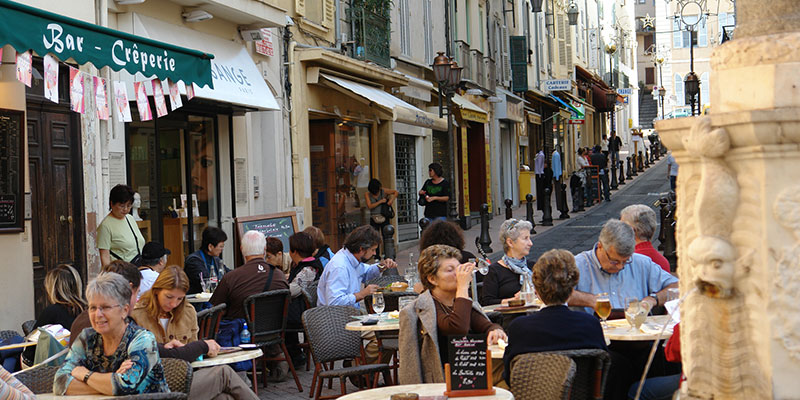
At the center of the Old Town you will find the Place Nationale. It is the destination to drop anchor if you want to sit down and have a drink or nice meal at one of the many restaurants around the square. It's always a prime spot to watch people, make the rendezvous, hang out for a while, sit down, rest and recharge. The Old Town is immediately all around it – within four blocks you've got most of the prime sights in easy reach. These few blocks in the center are really some of the sweetest in the entire Riviera. Because Place Nationale is in the middle of the Old Town you'll find that a variety of fascinating streets lead off from it in all directions -- some of them are quite narrow just for pedestrians and others are bit wider such as the Rue de la République.
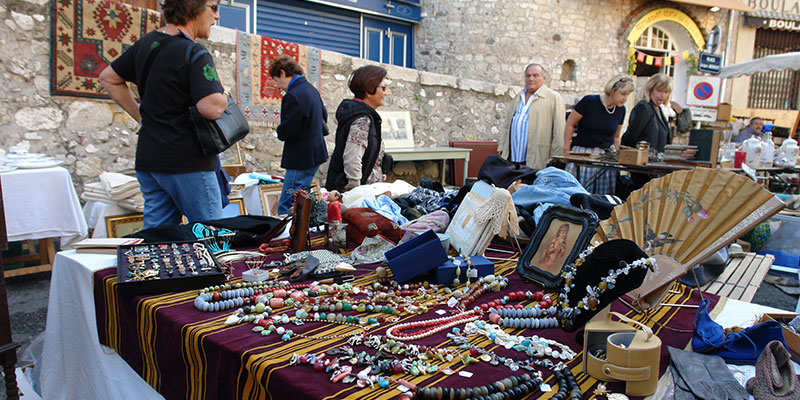
Every Saturday the Place Nationale is the host to a flea market from 7:00 am to 6:00 pm. You can rummage around here, look for some clothing bargains, get knickknacks, find local curios, or just do more people watching. You'll find that the locals are quite friendly at the open market, a good place to say hello, bonjour, and strike up a conversation.
There are several other clothing markets in town located in different places around the village depending on the day, so you should be able find it. They happen most every day and usually they run from 7 o'clock in the morning till 1 o'clock in the afternoon. It's a little down-market but it's fun to browse and fun to check out the locals getting their goods. Maybe you'd like to stop and get some gelato – there are Italian influence still here yet, but of course you can find gelato all over the world.
If you only had 2 or 3 hours you could see most of what we've described in this chapter about Antibes by just walking around, but if you have a little more time you could keep walking. That is up to you and your schedule.
-04.jpg)
One of the nicest pedestrian streets you'll find in the center is Rue James Close, just a block from Place Nationale. This narrow pedestrian route is lined with boutiques and restaurants that are so cute you just might want to drop anchor at a sidewalk café and sample the local grinds such as socca. One of the regional food treats the south of France. Socca is a like a crêpe and yet it's made from chickpea flour, so it's really hearty and tasty, good for you, a nutritious snack. It's not junk food by any means and it's really different than the standard crêpe, which is made from wheat flour. This is really quite a special thing. Of course you can have different toppings on it or just have it plain -- there so much flavor in the chickpea you don't need any special toppings, you don't need any sugar or jam or anything, just plain socca is really a satisfying treat. It’s especially found in the Ligurian area, anywhere from Nice around the coastline into Italy and down to Pisa.
This old Rue James Close is kind of a forerunner of today's modern shopping malls – these streets have always been too narrow for cars so it has been a pedestrian zone from the beginning. Walking along on Rue James Close almost feels like strolling through an outdoor museum -- the shop fronts are so interesting. You don't find the big chain stores here, they're all little boutiques with antiques, clothing, furnishings and artworks.
-04.jpg)
You can eat well and inexpensively with a takeout sandwich from one of the small convenience stores here: sit down on a step and watch the people walk past from your own little sidewalk perch. Even in expensive towns along the French Riviera you can always find a takeout sandwich place and get an inexpensive meal that is going to cost you under €5 and get a soft drink to go with it, find a place to sit and enjoy very inexpensive meal. Of course you do want to have some good foods on your travels as well but often at lunch you’re just moving along, you don't have a lot of time and you just want to grab something quick and simple.
By now you're beginning to get the picture of the good life in Europe. It's walking, it's the promenade, it's the cafés, the pastry shops, it's the food markets. It's all the things not found in most American places unfortunately. That experience of just walking around, seeing your friends, having a chat, having a coffee, is a big part of life here.
.jpg)
If you continue a few blocks further along Rue James Close, which becomes Rue des Revennes, turn left at the end then right and you will reach a peaceful residential neighborhood of narrow pedestrian alleys where you might get a little lost, off the beaten path, including Rue Castelet, Safranier and Tourraque. These narrow lanes are lined with stone homes packed in tightly together with rows of potted plants providing a little breather to make up for their lack of gardens. It's quite easy to find this small residential neighborhood, but frankly it's not a terribly exciting place to visit. I enjoyed it for the quiet diversion, but wouldn't put it at the top of the list of things to see in Antibes. If you've got at least three hours to look around the town, you will certainly have time for this little detour. You could just take 15 minutes for this kind of a wander – it's fun to see how the locals live.
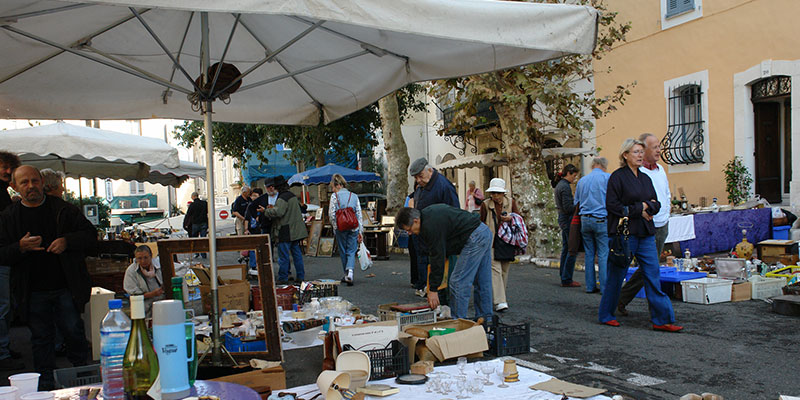
It's easy to find your way out of this small residential neighborhood because in just a few blocks you will return to the small commercial district of the Old Town, with the beautiful streets lined with the shops and cafés. Take Rue des Bains back to James Close and carry on. Another nice intersecting lane is Rue de Fersen, with the expected shops and cafes. By now they’ll look familiar but there are a whole number of streets that you might not have seen yet, so just go wander around some more and even if you're going down the same street again it’ll look different the 2nd or 3rd time around. As you wander along you are going to enjoy these little lanes and occasional buildings overhead forming tunnels to lure you along. Eventually you will find your way back to the main square, Place Nationale.
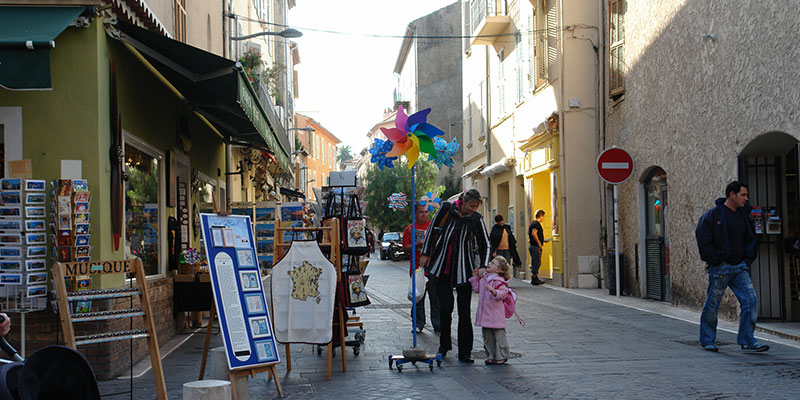
The main pedestrian shopping street of town, Rue de la République, runs along one side of the central square. It is busier, a little bit more modern than the narrow lanes of the Old Town, with lots of great shops and more eateries. The street is always lively with pedestrians, mostly locals out for a stroll and the odd scooter but there are no cars allowed. You can see how the sense of community and relations gets well established in a small town like Antibes with these extended families and friends running into each other on the walkways.
When done with your visit to Antibes it's easy to find the train station if that's how you are departing, but you don't have to walk back exactly the way you came along the marina. You can do an interesting stroll in less than 15 minutes from Place Nationale over to Place Gen. de Gaulle and then you turn right and walk five blocks along Avenue Robert Soleau back to the train station. It's quite easy and there are things to see along this route, which brings you into the modern part of Antibes.
That wraps up our visit to Antibes. You can see it's one of the great towns of the French Riviera. Of course there are many great places to visit here in the south of France –Cannes, Grasse, Monaco, Vence, Villefrance, St-Paul-de-Vence and others all of which we are covering in this book about the Mediterranean, so be sure to take a look.
-04.jpg)
It is possible to cover a lot ground and see three cities in one day, but be advised this would be a very full and demanding day. You can easily continue from Antibes to Cannes by train, in 7 minutes, spend several hours there, then carry on from Cannes to Grasse (25 minutes by train or 45 minutes by bus). It will be a long day but efficient if you are using Nice as your home base, because all three of these cities are to the west of Nice and clustered relatively close to each other. Then when done with Grasse, the train will bring you back to Nice in a return of the way you came. Alternatively, if you want to see all three of these cities from a base in Nice but don’t want to squeeze them into a single day, you will be going back and forth by train over two days, retracing your route in a less-efficient but perhaps more relaxed manner. The call is up to you.
Train service along the Riviera is really fantastic – on the main line the trains usually come every 15 to 25 minutes depending on time of day and it just takes 25 minutes to go from Antibes back to Nice by train.
A suggestion for your ticket purchase is buy a one-day pass, currently only €15 per person, which is good for unlimited travel on the rail for one day in the Riviera region, a very good bargain. It also makes it a lot easier at the station -- you don't have to hassle with buying tickets every time you get on the train.
It takes less than half hour to get from Antibes back to Nice and for the most part it's a scenic ride along the shoreline offering beautiful views of the blue Mediterranean. You'll find that staying in Nice is a perfect solution for seeing the Riviera because there are many hotels in Nice, there's a lot to see in Nice, and it's so easy to get around by train and also by public bus. This way you can see the little towns and villages of the Riviera very easily. The Nice train station is right in town and within a few blocks walk you are on the main boulevard of Nice, so you don't waste any time.
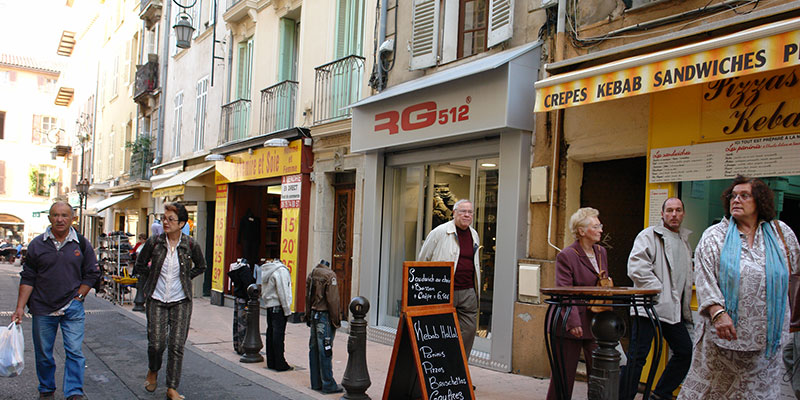
The area has been controlled for thousands of years by many different competing cultures that imposed their own political, cultural and trading systems for the control of Mediterranean commerce. Most likely there were prehistoric hunter-gatherers 30,000 years ago, then early fishermen and farmers who lived in this area for thousands of years. The written history begins about 2 1/2 years ago starting with a group called the Phocaeans, an ancient Greek culture that developed on the western shore of Turkey. They were the first Greeks to make long sea-voyages and came to Antibes and Nice from Marseille while establishing trading settlements throughout much of the Mediterranean.
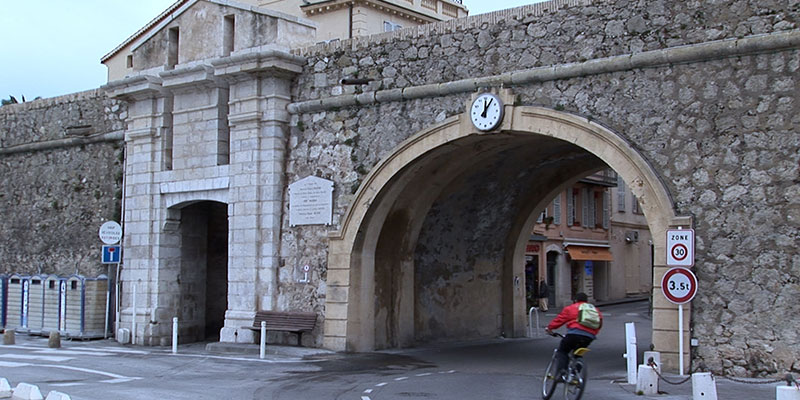
The favorable position of Antibes marked it long ago as a suitable site for an important town, located on an indentation of the coast, forming a secure harbor. On the one side is a rocky promontory jutting out a considerable distance into the sea, called the Cape of Antibes. On the other side is a succession of smaller and shorter promontories, which shape out the shore into little semicircular bays perfectly sheltered from the mistral. The views of the town from the seacoast are charming. Surrounded on the land side with its great stone walls, and protected on the south by its rocky seacoast, with the snowy mountains forming a background, and the bright blue of the Mediterranean in the foreground, a finer picture can hardly be imagined.
Since the days of the Greeks, Antibes has been a frontier fortress. Ruins of the fortifications of succeeding centuries show that the town has always been on the same site, on the coast east of the Cape, looking towards Nice. This seaport has had an almost uninterrupted existence since the fourth or fifth century before Christ, when it was founded by a Greek colony either from Nice or Marseilles. The Greek wanderers from antiquity found on these western shores natural features which characterized their own native land -- the same picturesque mountain scenery, fertile valleys, fine climate, and varied coast-lines of sharp projections and deep recesses. After establishing a colony at Masilia, the modern Marseilles, they proceeded from there to found Nice and Antibes. The ancient name of Antibes was, Antipolis, which indicates that it was over against Nice, the city, and that it was founded after Nice. They constructed here in Antibes a frontier fortress to protect them from the aggressive Ligurian tribes of Genoa to the east.
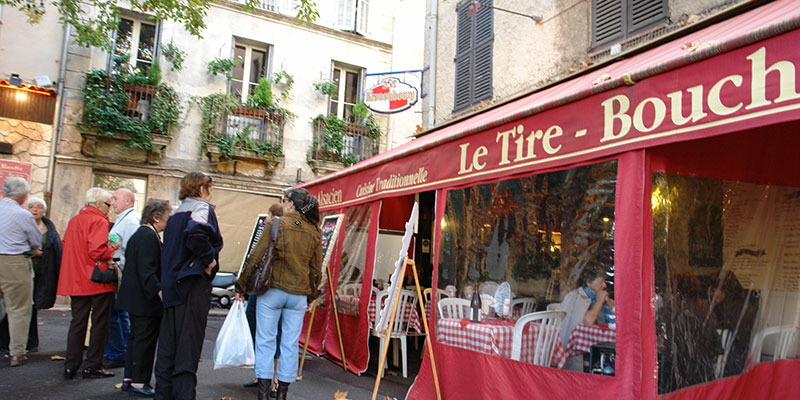
Proof of its early Greek origin has been established with the discovery of some stones inscribed with archaic Greek characters. Of course hardly any traces remain of the Greek town. The only relics of the ancient Roman city are two ancient towers in the center of its modern town, one of them standing just in the front of the former cathedral, and used as a belfry, and the other tower forms part of an adjoining official building.
These oldest existing structures stand on the highest point of the rock facing the sea. The two towers at Antibes are of peculiar interest -- one of the towers is in connection with an old palace which doubtless occupies the site of the ancient castle, being on the summit of the rock, and suitably placed for keeping a look-out seawards. The other tower is close to the cathedral and is still connected with it by a covered way on the first floor. These two towers are in the style of those of the Mont du Chevalier at Cannes. The church is very simple in design, and seems to have been originally similar to that of the city of Vence, but since greatly altered and a new front added in the seventeenth century.
There can be no doubt that in the time of the Romans the town had aqueducts, baths, theatres, you know, features typical of a Roman city with its many public edifices. It was, indeed, famous for the beauty of its monuments. It possessed a highly efficient school of navigation. Traces of Roman graves are still occasionally found, as well as carved stones, inscriptions, mosaics, and coins. It was formerly the headquarters of the army during the Roman occupation.
.jpg)
The later history of the town of Antibes is a very stirring one. It was destroyed by the Goths in 473, that was part of the fall of Rome in which the entire Roman Empire fell apart, conquered largely by the Goth invaders. And it shared the same fate at the hands of the Lombards a hundred years later in 578. The Saracens held possession of it for many years during the seventh century. They were the Muslim invaders from northern Africa and the East.
In early Christian times Antibes became the seat of a bishop, but being greatly exposed to the attacks of the Saracen Corsairs and others from whom it suffered severely, the bishop was removed in the year I243 and relocated for security purposes over to the town of Grasse. There were originally four bishoprics in this part of the Riviera: Nice, Antibes (afterwards Grasse), Vence, and Frejus.
In 1524 Antibes was taken by the Constable Bourbon, the French influence, and in 1536 it was sacked by Charles V of Spain. As a frontier town Antibes was greatly damaged during these wars between Francis I. and Charles V. of Spain, being frequently attacked and pillaged. Its ancient buildings have thus been almost entirely demolished, either by the direct effects of war or in the construction of the fortifications, so that scarcely a trace of that early occupation remains.
The present fortifications were erected about the time of Francois premier, and of Henry of Navarre, and afterwards greatly improved by Vauban under Louis XIV. Their erection had the beneficial effect of draining the marshy ground and rendering the air healthy. Its fortifications and the fortress of Fort Carré, on the graceful hill to the north side of the entrance of the harbor, built by Vauban in 1691, are still remarkably strong and well-preserved. These fortifications occupied a prominent place in the military movements of the French Revolution. Napoleon was for some time a prisoner in Fort Carré, and his mother resided near it in a small house. The town was surrounded by walls and on three sides by the sea, strongly fortified in the style of the seventeenth century, of which it is a fine example.
The Duke of Savoy seized Antibes in 1707, and forty years later it was bombarded by the English, and in 1813 by the Austrians. You can see it’s such a desirable piece of land everybody was fighting over it. Before Nice was annexed by France, this was the frontier line of France, which accounts for its being still so strongly fortified. The remains of a theatre and other ancient buildings attest to its former importance.
.jpg)
Only after Napoleon III seized the district of Nice as part payment for French intervention in the Italian war of liberation was that familiar term "French Riviera" gradually extended to include the coast as far west as Antibes. What was added to France under Napoleon III then lost its previous Italian character. People here had been speaking Italian and largely identifying with the main Italian society, but after Napoleon the Third everything switched to French…it took a while.
In summary, Antibes was so desirable it was captured in turn by Greeks, Romans, Carthaginians, Gauls, Teutonics, Franks, Saracens, Spanish and then Italians. The area experienced a strong Italian culture for hundreds of years, then finally, the French took firm control. And yet throughout all these millennia of changing political rule, it may be that the people, the basic population, did not change much and adhered to their ancestral southern French/Spanish Catalan culture with whom they shared a common culture and language, until the dominance of Louis XIV stamped the French imprint upon the society. The ongoing tradition of international invasions is now carried on by millions of tourists flocking annually to these lovely shores.
.jpg)